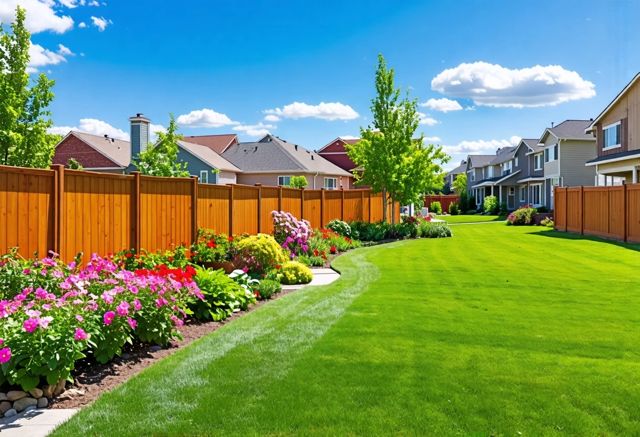HOA rules do not inherently favor wood fences over other materials. They focus on maintaining the community’s overall appearance and value through various guidelines.
Understanding HOA Rules on Fences
Homeowners Associations (HOAs) set guidelines that affect how fences are built and maintained in your community. Understanding these rules is vital for homeowners considering a wood fence. Here’s a closer look at what you might encounter:
- Purpose of HOA Rules:
- Maintain community aesthetics.
- Protect property values.
- Common Restrictions:
- Height Requirements: Many HOAs specify a maximum fence height, often around 5 feet.
- Material Limitations: Some associations may restrict certain materials, making wood fences subject to approval.
- Design Standards: HOAs might require fences to follow specific design patterns or color schemes.
- Application Process:
- Homeowners typically need to submit a fence proposal to the HOA board for approval.
- This process involves filling out paperwork and waiting for the board to review and decide.
- Maintenance Obligations:
- Homeowners are responsible for keeping their fences in good condition.
- Fences that fall into disrepair can lead to warnings or penalties.
- Potential Penalties:
- Unapproved fences may require removal at the homeowner’s expense.
- Other violations might lead to fines.
- Specific Guidelines:
- Some communities may even prohibit fences or place restrictions on where they can be placed.
- In certain states, laws dictate the legal height and type of fences allowed, with homeowners needing to be aware of these regulations.
HOA rules are not designed to favor wood fences over other materials. Instead, they focus on preserving the overall appearance and value of the community. Homeowners are encouraged to communicate with their HOA boards to navigate these complex regulations effectively.

Why HOAs Favor Certain Fence Types
Wood fences often face scrutiny from Homeowners Associations (HOAs) for a variety of reasons, mainly centered around aesthetic standards and community guidelines. Here’s why HOAs tend to favor certain types of fences, particularly those that minimize obstructions and maintain visual harmony in the neighborhood:
- Material Restrictions:
- HOAs typically impose strict guidelines on fencing materials to ensure a cohesive neighborhood look.
- Allowed materials often include wood, vinyl, wrought iron, or aluminum, while chain-link and other unconventional materials are usually prohibited.
- Style Preferences:
- Each HOA may require specific styles to complement architectural themes within the community.
- There are often regulations regarding the design and color of fences, ensuring uniformity across homes.
- Height Regulations:
- Maximum height limits are common to provide visibility and safety, particularly on corner lots.
- Most HOAs are more restrictive than local zoning laws, so it’s essential to check both sets of regulations.
- Color and Finishing:
- Color choices may be restricted to a palette approved by the HOA, ensuring that fences blend well with surrounding properties.
- Finishing requirements may dictate whether paint or stains are used, furthering aesthetic consistency.
- Setback Requirements:
- Setback rules govern how far fences must be from property lines, influencing placement and design.
- These regulations help maintain a uniform appearance and prevent fences from obstructing views or becoming eyesores.
- Integration with Landscape:
- Some HOAs encourage fences that integrate with the natural environment, like preserving trees or using landscaping elements alongside fences.
- Maintenance Obligations:
- Homeowners are generally responsible for the upkeep of their fences, which may include repairing damage or ensuring compliance with HOA regulations.
- HOAs may conduct routine inspections, monitoring fences for maintenance issues.
Wooden fences, while a traditional choice for many homeowners, can obstruct views and may not uphold the aesthetic standards an HOA seeks. For example, wooden fences are known to catch wind, which can be problematic in certain climates. Substituting or supplementing wood with materials like ornamental or wrought iron fences can offer a balance of visibility and style while complying with HOA guidelines.
Understanding these HOA preferences can help homeowners navigate the complex landscape of fence installation. By aligning fence choices with HOA regulations, residents can maintain the beauty of their community while fulfilling their privacy and security needs.
The Impact of Wooden Fences on Property Value
- The installation and upkeep of a wooden fence can play a significant role in maintaining or increasing property value within a neighborhood.
- Homeowners associations (HOAs) often regulate the types of fences permitted in a community. They favor wood fences due to their classic appearance and ability to enhance curb appeal.
- Key considerations for wooden fences include:
- Curb Appeal and Aesthetics: A well-maintained wooden fence can elevate the visual appeal of a home and contribute positively to the neighborhood’s charm.
- Material Quality and Durability: While wood offers a traditional look, it requires regular maintenance to avoid decay, pests, and weather damage.
- Privacy and Security: Wooden fences provide effective barriers for privacy, enhancing home security and value.
- Maintenance and Longevity: Regular maintenance is essential; neglecting this can lead to issues that might deter buyers.
- Compliance with HOA Regulations: Homeowners must adhere to the guidelines regarding fence height, style, and color. Non-compliance can lead to penalties, including fines or removal.
- Homeowner considerations when choosing a fence:
- Aesthetic Cohesion: Ensuring the fence reflects the neighborhood’s design standards can protect property value.
- Resale Value: High-quality wooden fences often appeal to potential buyers, supporting better resale opportunities.
- Legal Compliance: Applications for fence installation must be submitted to the HOA to attach value without legal risks.
Following these guidelines helps maintain the community’s overall aesthetic and positively influences property values, making wooden fences a popular choice among homeowners adhering to HOA rules.

Navigating HOA Compliance for Wood Fences
When planning to install a wood fence, homeowners must navigate a maze of guidelines to ensure HOA compliance. Many homeowners associations (HOAs) enforce their rules to safeguard the visual integrity of the neighborhood. Let’s explore key points that can help with this process:
- Familiarization with HOA Guidelines:
- Homeowners should start by reviewing the Covenants, Conditions, and Restrictions (CC&Rs) and Architectural Control Guidelines specific to their HOA. These documents outline crucial details such as:
- Approved materials
- Height limitations
- Specific designs or colors that may or may not be permitted
- Project Approval Process:
- Before any construction begins, it’s essential to submit a project proposal to your HOA. This proposal should include:
- Fence plans
- Material specifications
- Many HOAs have a dedicated Architectural Committee that reviews submissions for compliance.
- Choosing the Right Contractor:
- Hiring a licensed contractor can help ensure that the installation meets HOA standards. An experienced contractor is familiar with local regulations and can guide homeowners through the process.
- Common HOA Requirements:
- Typical requirements may include:
- Rectangular designs
- Maximum heights of 4 feet
- Specific materials, such as white vinyl, in some communities
- Some HOAs might necessitate maintaining landscaping around the fence, with agreements attached to applications.
- Permits and Local Regulations:
- Beyond HOA guidelines, municipalities may require additional permits for fence installations. Check local regulations to avoid any conflicts.
- Avoiding Legal Issues:
- Ignoring HOA rules can lead to complications. Noncompliant installations may result in:
- Fines
- Orders to modify or remove the fence
Understanding these aspects is critical for homeowners eager to install a wood fence while adhering to HOA standards. This diligence not only preserves neighborhood aesthetics but also protects property value.

FAQ
What is the purpose of HOA rules on fences?
Homeowners Associations (HOAs) set guidelines to maintain community aesthetics and protect property values.
What are common restrictions imposed by HOAs on fences?
Common restrictions include height requirements, material limitations, and design standards. For example, many HOAs specify a maximum fence height, often around 5 feet, and may restrict certain materials and require specific design patterns or color schemes.
What is the typical application process for getting a fence approved by an HOA?
Homeowners usually need to submit a fence proposal to the HOA board for approval. This process involves filling out paperwork and waiting for the board to review and decide.
What maintenance obligations do homeowners have for their fences under HOA rules?
Homeowners are responsible for keeping their fences in good condition. Fences that fall into disrepair can lead to warnings or penalties from the HOA.
What are the potential penalties for non-compliance with HOA fence rules?
Unapproved fences may require removal at the homeowner’s expense, and other violations might lead to fines.
Do HOAs favor wood fences over other materials?
HOA rules are not designed to favor wood fences over other materials. Instead, they focus on preserving the overall appearance and value of the community.
Why do HOAs favor certain types of fences?
HOAs favor certain types of fences to ensure a cohesive neighborhood look, maintain visual harmony, and comply with aesthetic standards and community guidelines.
What are some common material restrictions imposed by HOAs?
Allowed materials often include wood, vinyl, wrought iron, or aluminum, while chain-link and other unconventional materials are usually prohibited.
What style preferences might an HOA have for fences?
Each HOA may require specific styles to complement architectural themes within the community, including regulations regarding the design and color of fences.
What are typical height regulations for fences under HOA rules?
Maximum height limits are common to provide visibility and safety, particularly on corner lots. Most HOAs are more restrictive than local zoning laws.
What color and finishing restrictions might HOAs impose on fences?
Color choices may be restricted to an approved palette, ensuring that fences blend well with surrounding properties. Finishing requirements may dictate whether paint or stains are used.
What are setback requirements for fences under HOA rules?
Setback rules govern how far fences must be from property lines, influencing placement and design to maintain a uniform appearance and prevent obstructions.
How can fences integrate with the landscape according to HOA guidelines?
Some HOAs encourage fences that integrate with the natural environment, such as preserving trees or using landscaping elements alongside fences.
How do wooden fences impact property value?
A well-maintained wooden fence can elevate the visual appeal of a home and contribute positively to the neighborhood’s charm, enhancing property value.
What are the key considerations for wooden fences in terms of maintenance and longevity?
Wooden fences require regular maintenance to avoid decay, pests, and weather damage. Neglecting maintenance can lead to issues that might deter buyers.
How can homeowners ensure compliance with HOA regulations when installing a wood fence?
Homeowners should review the HOA’s Covenants, Conditions, and Restrictions (CC&Rs) and Architectural Control Guidelines, submit a project proposal for approval, and hire a licensed contractor familiar with local regulations.

